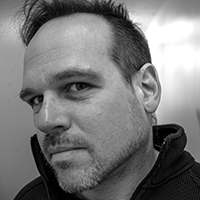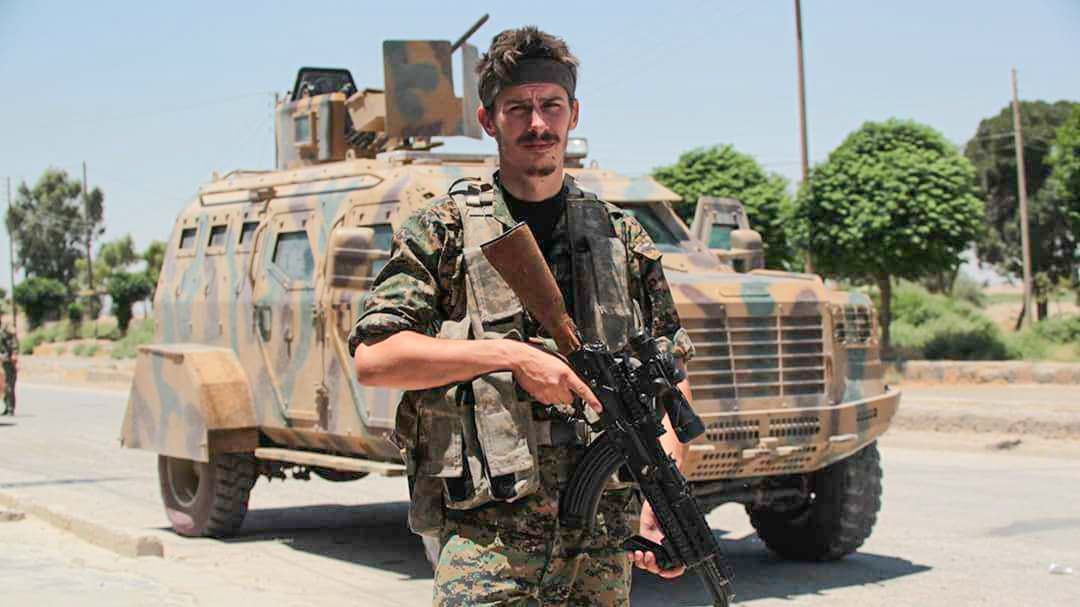An American killed while fighting ISIS can’t come home.
Robert Grodt wasn’t a U.S. soldier, he was a former Occupy Wall Street protester who joined up with a Kurdish militia in Syria to fight the so-called Islamic State. Grodt’s family said it blames the State Department for their inability to give their son a burial at home.
“Our government continues to fuck things up getting Rob home. It's a disgrace,” Martha Dedrick, the mother of Grodt’s partner, Kaylee, told The Daily Beast via email.
ADVERTISEMENT
Grodt, 28, was with a Kurdish-led militia called the People’s Protection Units, or YPG, that is at the forefront of the ground war against the so-called ISIS. Grodt was killed on July 5 fighting ISIS in Raqqa alongside fellow YPG volunteers Nicholas Warden, of Buffalo, New York, and Luke Rutter of Birkenhead, England. A third American YPG volunteer, David Taylor Jr. of Florida, was killed in July as well, according to his father, David Taylor Sr. The three Americans’ remains have yet to be repatriated.
A recent memorial service for Grodt in Zuccotti Park, birthplace of the Occupy Wall Street movement, also carried a message of protest for the State Department: bring the dead home so their families can bury them in American soil.
Ron Kuby, a civil rights attorney representing the Dedricks in their effort to get their Grodt’s body returned to the U.S., said the delay in returning Grodt’s remains is compounding the family’s grief, and blamed inexperienced State Department staff unfamiliar with the chaotic environment in Syria.
“The State Department is responsible for arranging the repatriation of Rob’s body back to the United States,” Kuby said. “But due to lack of experience in dealing with the complex relationship among the various parties involved in the Syrian civil war, low-level staffers at the State Department are learning their job while on the job."
A spokesperson for State Department said in a statement, “We can confirm that three U.S. citizens were killed in Syria. We express our sincere condolences to their family and friends. Out of respect for their families during this difficult time, we have no further comment at this time.”
Grodt grew up in Simi Valley, California, before hitch-hiking across America to join Occupy Wall Street protests in New York in September 2011. There, he volunteered a s medic and met his future partner, Kaylee, after she was pepper-sprayed by police. The two fell in love and had a daughter together.
After Occupy protesters were evicted by police from Zuccotti Park in November that year, Grodt joined Kaylee and her mother, Martha, in the small upstate New York town where they lived.
Grodt was inspired to go to Syria in 2015, when Kurdish forces broke the ISIS siege of Kobani, a city in the country’s Kurdish region of Rojava, which declared itself an independent state the year before. Rojava’s constitution says it guarantees “democratic confederalism,” a kind of direct, socialist democracy. The YPG fights ISIS for control of Rojava.
“Contributing with the revolution,” Grodt, said in a YouTube video two weeks before he died, “is a very big part of why I’m here. It’s also about setting an example. This is a fire that may have started here, but it can kindle elsewhere.”
Anthony DelGatto, an American from Brooklyn who previously served in the Air Force, told The Daily Beast he trained with and fought beside Grodt and the others in Syria. He detailed his experience there, including the brutal urban combat the group faced fighting ISIS.
DelGatto first met Grodt at an airport in Qatar his way to Syria. He suspected Grodt was heading to the same place he was: Grodt’s desert combat boots were the tell.
They ended up in the same class at the military training center all foreign volunteers go through when they enlist with the YPG It was at the academy in Rojova, DeGatto says, that the volunteer group they were part of was nicknamed “the 50/50.”
“We were watching a movie called War Dogs in the dining room over at the academy in Rojava,” DelGatto recalls. “In the movie there’s a part where they joke around driving through Iraq and they say to the driver, ‘Is this gonna be dangerous?,’ and the driver says ‘50/50. And they say 50/50 what? ‘50% we die, 50% we live.’”
“We all laughed about that. And the commander at the academy says ‘You guys: the 50/50.’ So that was the name of our group. Me, Rob, Nick Warden and Luke Rutter, from the U.K. They were all killed together.”
Though Grodt had no prior military training, “He knew how to shoot better than us,” DelGatto remembered, referring to the volunteers who, like himself, had previous military experience. “He even taught us to shoot, strip and clean an AK-47.”
Grodt had some experience target shooting with rifles “as a kid in Simi Valley,” Dedrick said,but he did not own or shoot a firearm in the six years after Occupy Wall Street.
“What he did in Syria is just a testament to how brilliant he was,” she wrote via email. “He could pick anything up with minimal effort. He never used an AK 47. Ever. The guy was SMART.”
After the academy, DelGatto participated in the successful spring offensive to seize the Tabqa dam and the city of Tabqa from the ISIS, Delgatto said, while Grodt was part of an infantry force sent to encircle the city of Raqqa in preparation for an all-out assault on the last ISIS stronghold.
Once Tabqa was secured in June, the Battle for Raqqa began. DelGatto joined the fight.
“This is their last stand. They’ve had since 2014 to fortify [the city],” DelGatto said of ISIS. “Everything is rigged with mines, booby-traps. You go to open a door to a building – boom. You’ll see a tricked-out rifle leaning up against a wall with optics – ‘Oh look at this ...’ boom.”
DelGatto said Kurdish forces go on the offensive at night, to take advantage of the night-vision goggles a few of them have. When an infantry squad approaches a building, it surrounds it, smashes its windows and hurls grenades inside. “Blow up whoever’s there, and to detonate whatever they had rigged.”
Sometimes, he said, a sledge-hammer is used to smash a hole through a wall. Then soldiers insert the barrel of a “bixie” – a belt-fed, light fmachine gun – and spray the interior with gunfire
Once inside a building, they go room-to-room, floor-to-floor, until they are certain no living ISIS fighters are inside. Each unit secures two, three, maybe four buildings per night.
Grodt, says DelGatto, was participating in an operation like this when his squad was ambushed.
Erem Kansoy, a photojournalist on assignment in Raqqa for the British newspaper Telgraf, told The Daily Beast previously unreported details about Grodt, Warden, and Rutter’s final days.
Kansoy said he encountered Grodt, Warden and Rutter on the battlefield “a couple of days before they died.
“I always saw him at the frontline nearly everyday,” Kansoy said of Grodt.
The two Americans and Brit were part of a six-man squad returning from an offensive operation to kill ISIS fighters when they were ambushed, Kansoy said. They were “inside the Raqqa city in the east frontline,” moving among buildings heavily damaged in previous fighting, near a bomb-cratered road. ISIS fighters lay in wait after planting a mine and concealing themselves in the rubble.
Warden, Kansoy believes, stepped on the mine, “as he was lost a leg when he came first aid point. And one side of body was damaged. The signs show Nick stepped on mine.”
When the mine exploded, ISIS fighters directed small arms fire and rocket-propelled grenades at the group.
Grodt was killed instantly when a rocket hit “very close to him,” Kansoy said. Rutter, Warden and two Kurds also died. Only one “heavily injured Kurd survived, he said.
The YPG quickly launched an operation to recover Grodt’s body. To do it. they had to fight their back to the site of the ambush, two kilometers away. “Daesh was still attacking,” Kansoy said, using the Arabic term for ISIS, but the recovery force “killed all Daesh around.”
As Kansoy waited, he washed Rutter and Warden’s bodies and wrapped them in plain white sheets, in accordance with Islamic tradition.
“I couldn't do it for Robert,” Kansoy said. “You know, emotions.”
DelGatto had returned to the United States to deal with a family emergency and was back home when Grodt died. While there, he found a note that Grodt had surreptitiously slipped into his gear some time during their last meeting.
“Handle what you have to handle and get your ass back here. See you in Raqqa bitch.”
But it was not to be.
“Absolutely just devastated and heartbroken over what happened,” DelGatto said. “We loved each other, we loved each other to no end.”
Grodt’s memorial ceremony in lower Manhattan began near noon with the unfurling of a black-and-red banner emblazoned with his name and the words: “NEVER FORGET THE FALLEN. FIGHT LIKE HELL FOR THE LIVING.” Occupy organizers spread word of the gathering by mouth, avoiding social media so as not to attract police and other unwanted attention.
Still, dozens attended the service in Zuccotti Park, where mourners played a film provided by the Kurdish militia. The video showed Grodt’s coffin receiving a hero’s sendoff from the battlefield, accompanied by cries of “Shaheed!” and the ululations of female militia fighters. Friends and supporters gathered around the screen and watched. A few cried softly.
When the video ended, some stepped forward and shared memories of Grodt.
“We were the first two people here,” said Marissa Holmes, a visual documentarian, referring to the first time Occupy Wall Street protesters entered Zuccotti Park. “He was always incredibly courageous. He put his body on the line for the movement.”
Edward T. Hall, III, who was also there in those early days, amplified Holmes’ remarks: “He didn’t have a drop of fear, at all. Or apprehension.”
The event ended with a march to the Federal Building in Foley Square, where mourners hoped to make their repatriation demands directly to State Department officials. When they arrived, they were met by guards who said the building was closed for the weekend.
A larger, public memorial is planned for September 4 in New York City, at Theatre 80.
“It’s time to bring them home,” said Alexander Appel, an Occupy Wall Street
participant who helped organize the memorial. “This is about all of them.”






